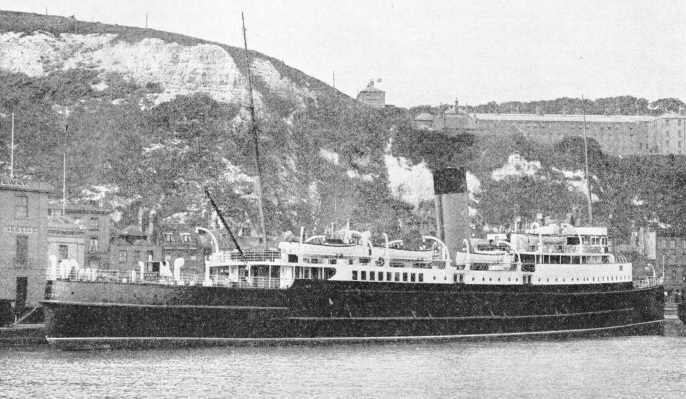

© Shipping Wonders of the World 2012-

Britain’s Passenger Ports
Apart from the great centres such as London, Glasgow and Southampton, which handle mainly ocean-
ONE OF THE BEST KNOWN PACKET PORTS is Folkestone, Kent. From here two daily services are in operation across the Strait of Dover to Boulogne, France. The Isle of Thanet, above, is a Southern Railway steamer of 2,701 tons gross. Built in 1925, she has a length of 329 ft. 6 in., a beam of 45 ft. 1 in. and a depth of 17 ft. 1 in. Four steam turbines drive her twin screws through single-
IN addition to such large passenger centres as London, Southampton and Liverpool, there are a number of ports in Great Britain which can claim to be among the country’s most important passenger ports. Round the coasts which face the Continent, for instance, there is a group of ports which, but for the fact that they are the terminals of packet services which connect with the big Continental cities, would scarcely be ports at all.
Their equipment varies from mere quays with sheds and a few cranes to more ambitious schemes embracing loading docks for train ferries and cargo handling facilities. All have one thing in common. The towns whose names they take are relatively small and the railway sidings at the back of them are extremely large.
Some of these ports are comparatively quiet by day but are exceedingly active in the evening and in the early morning. In others, the harbour master, his assistants and a large customs staff are kept busy every few hours by the arrivals and departures of cross-
In England and Wales, the principal ports within this group include Harwich, Dover, Folkestone, Newhaven, Weymouth and Fishguard. On the west coast there are also such ports as Heysham and Holyhead, described in the chapter “LMS Steamship Services”.
At Harwich on any night there is a tremendous bustle from the early evening onwards. Packets to Esbjerg, the Hook of Holland, Antwerp and, in the summer, a special service to Zeebrugge, are regularly handled from its long and busy quays, in addition to a nightly ferry service and one or two cargo services. There is also a day service to Flushing. The quays at Harwich have recently been improved by the addition of new sheds and waiting rooms, new coal-
All this volume of traffic amounts at peak period in the summer on one evening alone to nearly 2,000 people, with their baggage, motor cars and all kinds of miscellaneous and urgent freight. Much of this traffic must be handled between 9.30 p.m. and 11 p.m. The trains, too, which bring in the passengers must be brought alongside a single platform, emptied, shunted out and put into the sidings ready for cleaning and revictualling for the return journey to London.
Harwich in the morning is equally busy. A ship arrives in the early hours from the Hook of Holland bringing passengers from places as far distant as Budapest and Bucharest. Another comes from Antwerp with passengers from all over Belgium and, in the summer, the tourist ship comes in from Zeebrugge. Also there are arrivals of cargo vessels with fresh vegetables from the Continent, and there is also a train ferry which, among its varied deck cargo, may contain refrigerator fruit vans from Italy. No sooner have the London-
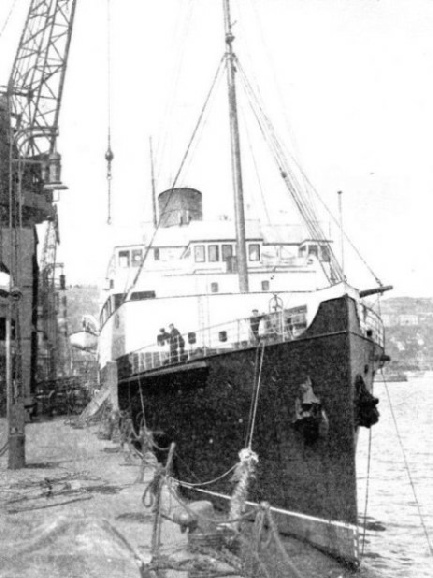
AT THE QUAY AT DOVER is berthed the Maid of Kent, a twin-
The inward-
Between the late morning and the early evening, which marks the sailing of the Danish boat, the long passenger platform at Parkeston Quay, which is the station for Harwich Harbour, is given over to local trains running between Manningtree (Essex) and Harwich Town. The old platform is still made of wood, for the new big platform, with its tall steel sheds and waiting-
The station buildings themselves comprise a number of waiting-
At the far end, nearest the train ferry slip, which is in Harwich proper, will be found buff-
Bursts of Energy
Ahead of her, if it is summer, will be found the Zeebrugge ship, and then a group of cargo vessels, attractive-
Work is proceeding on the cargo vessels — loading and unloading — and goods trains are being filled alongside. Coaling plant is working in one of the packet vessels. The plant has its spout closely attached to the circular bunker hatch abaft the funnels on the top deck.
Harwich has no facilities for dry docking. There is a sheer legs which can remove portions of machinery, but usually when the L.N.E.R. ships based on Harwich require to be docked they proceed to the Thames to one of the many dry docks on that river. Facing the big quay at Parkeston is the flat Essex landscape, and one or two barges may be beating up against the tide and some coasters are seen anchored farther down the river.
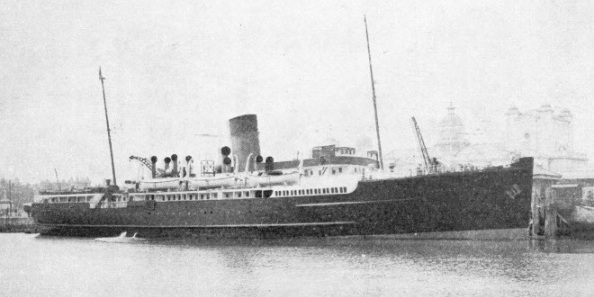
A TWIN-
The best impression of the vital importance of Harwich may be gained when approaching it comfortably seated in the Pullman Car of a boat train. When the train is going round the curve just before entering the station, there is a veritable cluster of life to be seen. If it is a rough night, cargo lamps are blowing about on the end of derricks, cargo is busily being hurried on board, passengers are walking up the gangway, and smart white-
The cosmopolitan crowd is surging up and down the platform with porters taking baggage and telling them that they will be met on the ship. The lynx-
Train Ferries
Somewhat similar scenes are enacted at the other ports. Dover, however, being one of the key ports in the Continental trade, is far busier than Harwich. The sea passage is shorter, too, so that the same ships are in and out of harbour more often. Dover handles services to Calais under the British and French flag jointly and also to Ostend under the Belgian flag. The facilities were increased in October 1936 by the inauguration of a train-
Among the fastest of the cross-
Dover is entirely different from Harwich as a harbour. The harbour at Harwich consists of a long wooden quay and of a steel and concrete quay, on a long river estuary; but Dover is built out into the sea on stone piers. So, too, is Folkestone. Harwich has a large number of sandbanks at its entrance. Dover has only the Goodwin Sands, but they are mercifully some distance away.
It must be a bad sea indeed to stop the nightly Harwich-
Newhaven has a quay but no pier. In this it resembles Harwich. Although over 11,000 people are dealt with in a busy week, there are only two services a day at Newhaven. Here, too, there are waiting-
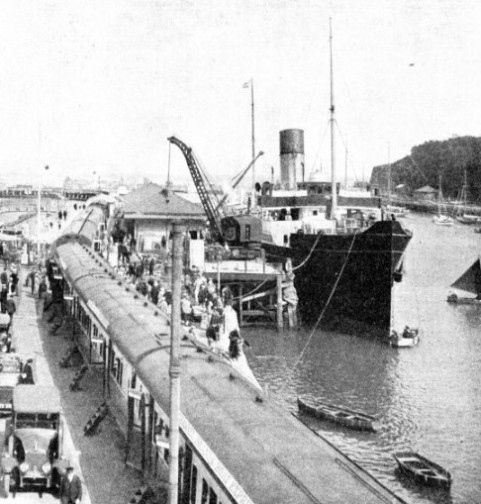
WEYMOUTH PIER is the scene of great activity on the arrival of the Channel Islands Boat Express to connect with the Great Western Railway’s steamship service to the Channel Islands. The St. Julien is a twin-
It is not always appreciated how important these little harbours are in the link of communications. The Dover-
Two of the largest vessels owned by the Great Western Railway operate on the services between Weymouth (Dorset) and the Channel Islands. The ships are the St. Julien and the St. Helier, twin-
From Fishguard, in South Wales, a service is operated by the Great Western Railway to Rosslare, in Ireland. This service was inaugurated in 1906, and the vessels are owned by the Fishguard and Rosslare Railways and Harbours Company. The St. Andrew and the St. David, twin-
The service is augmented by the City of Cork Steam Packet Company’s ships, which run on alternate nights to Cork. With their black-
Across the North Sea
At the great port of Southampton there is one little backwater from which Southern Railway steamers leave three times weekly for Havre and for the Channel Islands. These services run nightly in summer. There are also other Southern Railway services between Southampton and the French coast, such as those to St. Malo and Caen.
The dry docks adjoining are the headquarters for dry docking and ship repairing for the whole of the Southern Railway’s cross-
From Liverpool, too, there is a packet service maintained to Belfast by the ships of the Belfast Steamship Company. The British and Irish Steam Packet Company similarly maintains a nightly service to Dublin. These vessels are all berthed in Prince’s Dock, in Liverpool. They sail in the evening and arrive early in the morning.
Some of these packet ports have a regular traffic and the numbers of passengers vary little except for peak times at certain regular holidays such as Christmas. This is true of the Liverpool-
There is one further packet port which we have not yet mentioned, and that is Newcastle-
The Venus was completed in May 1931 at Helsingor (Elsinore), Denmark. A twin-
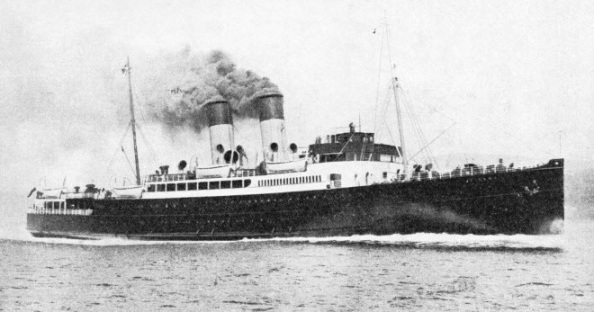
REGISTERED AT HARWICH and owned by the London and North Eastern Railway, the Vienna is one of the vessels running nightly between Harwich and the Hook of Holland. A twin-
You can read more on “Dover-
You can read more on “Train Ferries” in Railway Wonders of the World
